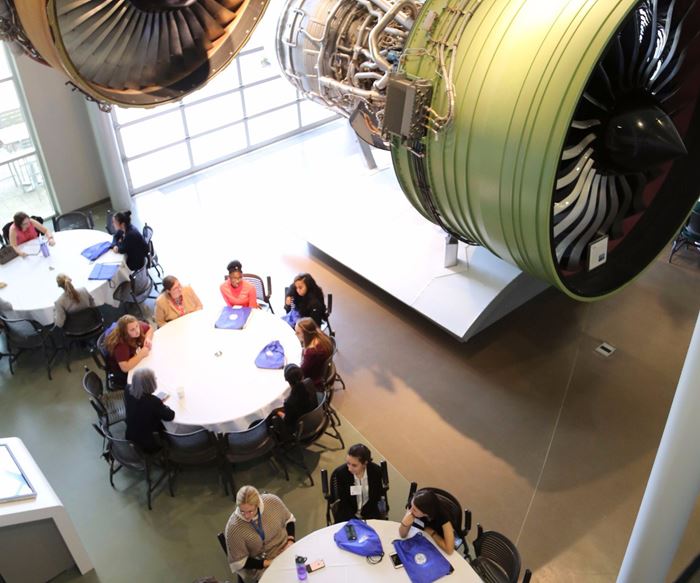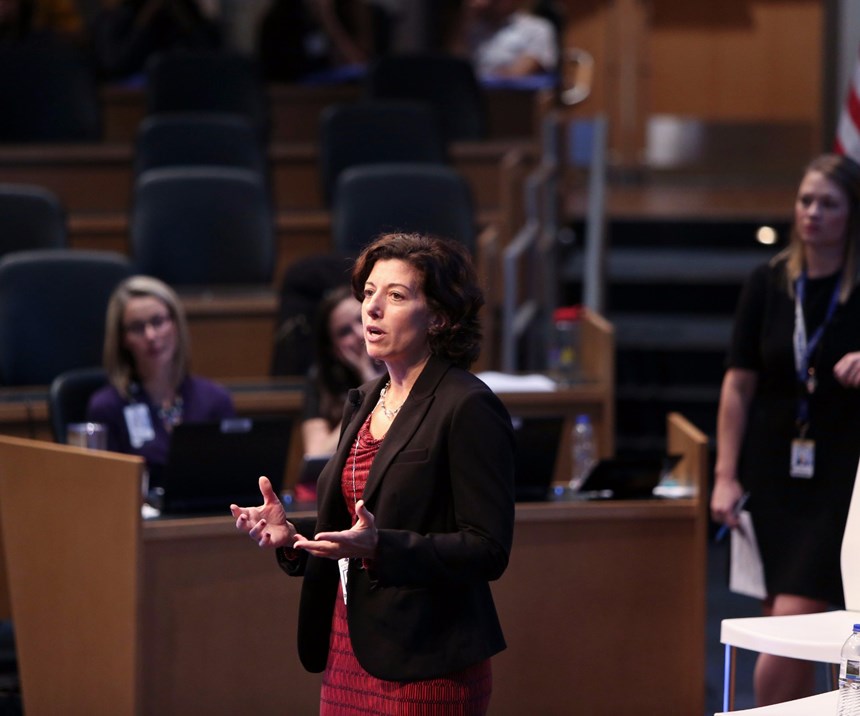Event Connects High School Girls to Women in Manufacturing
As companies project a future with more manufacturing jobs than candidates to fill them, some are partnering with organizations to recruit students from a traditionally untapped market.
Share








Hwacheon Machinery America, Inc.
Featured Content
View MoreWith concern growing about a lack of skilled workers to fill open manufacturing jobs in the coming years, some companies are looking specifically to women to fill the gaps. According to Bureau of Labor Statistics data, women account for 47 percent of total employment, but just 27 percent of manufacturing employment. “Women are overlooking these jobs, and these jobs are overlooking women,” says Debby Coombs, director of industry partnerships at Partners for a Competitive Workforce (PCW), a Cincinnati, Ohio-based organization that works to fulfill local workforce needs in industries including advanced manufacturing.
To address this issue, PCW partnered with GE Aviation to host a Women Leaders in Manufacturing Summit event for high school girls, which was attended by more than 130 students from 20 area high schools. Participants had the opportunity to ask questions during a panel discussion with GE Aviation employees and participate in smaller, round-table conversations with female employees of GE. Presentations and demonstrations of additive manufacturing and robotics gave the students a look at the technology with which they could be working. Alicia Hammersmith, general manager of materials value stream at GE Aviation’s supply chain division, also gave a keynote address about her experience as a woman in manufacturing over the course of her 25-year career.
This year’s event was based on a similar event GE Aviation’s Lauren Tubesing and Malissa Gallini spearheaded last year. The previous event, which focused more broadly on women and leadership, was the result of their efforts within the GE Women’s Network, a group that connects women within the company, to connect with female students interested in science, technology, engineering and math (STEM). Before that, the two had been organizing small-scale events at area high schools. “Both of us wished, when we were in high school, that we could have engaged with women in the workforce,” Ms. Gallini says. “Thinking about it early makes you a leader.”
According to Ms. Gallini, the decision to join with PCW for the event was a natural one. “We have similar missions,” she says. Sean Kelley, the director of PCW’s talent pipeline initiative, notes that the organization initially focused on adult workforce needs. But about four years ago, the organization realized that employers’ needs were so great that it needed to reach out to school-aged kids. Now it connects school districts to career-based learning opportunities via programs that focus on changing the perception of manufacturing. The organization also hosts an event for students in junior high in addition to the one for high schoolers.
According to PCW’s Director Janice Urbanik, a push to get women into engineering occurred in the 1980s. She was a beneficiary of this movement and worked as a mechanical engineer at GE. Eventually, she moved into workforce development, where she noticed that a lot of women had left the field.
Retaining women who enter these fields will be a key to making change stick. Ms. Hammersmith says that she feels fortunate that GE has been willing to work with her, but that women should be aware of their constraints and ask for the flexibility they need (in terms of schedule, location, etc.). As more women advance to the top of the field, they will be able to serve as role models and advocates for other women. Many of the leaders to whom Ms. Hammersmith credits her success were diverse. She says these managers “pulled her up” to new positions, even when she did not feel ready. She adds that lack of self-confidence often causes women to feel hesitant or cautious about taking big career steps.
There is reason to have hope about the self-confidence of the next generation. Princeton High School Senior Counselor Christina Grabel brought seven students to the event based on teacher recommendations. According to her, efforts to increase the number of students in STEM classes have been successful. She adds that girls are no longer intimidated by these subjects, and they even use this perception as a motivator. “I just don’t see those confidence issues anymore,” she says. “They’re out to prove a point.”
Related Content
Finding Skilled Labor Through Partnerships and Benefits
To combat the skilled labor shortage, this Top Shops honoree turned to partnerships and unique benefits to attract talented workers.
Read MoreHow to Pass the Job Interview as an Employer
Job interviews are a two-way street. Follow these tips to make a good impression on your potential future workforce.
Read MoreInside Machineosaurus: Unique Job Shop with Dinosaur-Named CNC Machines, Four-Day Workweek & High-Precision Machining
Take a tour of Machineosaurus, a Massachusetts machine shop where every CNC machine is named after a dinosaur!
Read MoreHow I Made It: Amy Skrzypczak, CNC Machinist, Westminster Tool
At just 28 years old, Amy Skrzypczak is already logging her ninth year as a CNC machinist. While during high school Skrzypczak may not have guessed that she’d soon be running an electrical discharge machining (EDM) department, after attending her local community college she found a home among the “misfits” at Westminster Tool. Today, she oversees the company’s wire EDM operations and feels grateful to have avoided more well-worn career paths.
Read MoreRead Next
Building Out a Foundation for Student Machinists
Autodesk and Haas have teamed up to produce an introductory course for students that covers the basics of CAD, CAM and CNC while providing them with a portfolio part.
Read More5 Rules of Thumb for Buying CNC Machine Tools
Use these tips to carefully plan your machine tool purchases and to avoid regretting your decision later.
Read MoreRegistration Now Open for the Precision Machining Technology Show (PMTS) 2025
The precision machining industry’s premier event returns to Cleveland, OH, April 1-3.
Read More








































.jpg;maxWidth=300;quality=90)

.jpg;maxWidth=300;quality=90)









